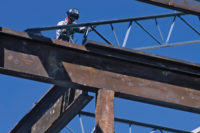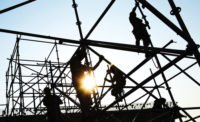NIOSH-OSHA campaign outlines a comprehensive process for fall prevention
The campaign’s goal is to prevent falls from roofs, ladders and scaffolds by encouraging construction contractors to plan ahead, provide the right equipment and train everyone to use the equipment safely.

Plan ahead
Each fall protection plan must be site-specific, but every plan will include the following general elements:
(1) A statement of policy. For example: ABC Company is dedicated to the safety and protection of our workers from injuries on the job. Each employee has the responsibility to work safely. The purpose of this plan is to (a) provide safety standards specifications designed to cover fall protection on this job and, (b) to ensure that each worker is trained prior the start of the job.
(2) This plan is designed to enable both employer and employee to recognize fall hazards on this job.
(3) Each employee must understand their value to the company; costs of accidents — monetary, physical and emotional; objective of the safety policy and procedures; safety rules that apply to the safety policy and procedures; and what their individual role is in administering, implementing, monitoring and compliance of their safety policy and procedures.
(4) A conference must take place prior to starting work involving all members of the crew, and supervisors of any other concerned contractors. This conference will be conducted by the supervisor in charge of the project. During the pre-work conference, procedures and sequences pertinent to this job will be thoroughly discussed and safety practices to be used throughout the project will be specified.
Providing equipment
Phase 2 of the program is providing the right equipment. Workers may be protected by:
(1) Guardrail Systems
(2) Safety Net Systems
(3) Fall Restraints Systems
(4) Positioning Device Systems
(5) Personal Fall Arrest Systems
Guardrails should have a top height from 39 to 45 inches above the walking level with mid-rails installed in the halfway position, if there is no wall or parapet at least 21 inches high. When conditions warrant, the height of the top edge may exceed 45 inches provided the system meets all other required criteria. The system must withstand a force of not less than 200 pounds when applied within 2 inches of the top edge. Refer to Appendix G in Subpart R for complete specifications.
Safety Net Systems, when used, are to be installed as close as practicable under the working surface, never more than 30 feet. The nets will extend outward from the work surface as indicated in Table. 1.
There must be sufficient clearance underneath to prevent contact with the surface below when subjected to a specified drop test. Mesh openings cannot exceed 6 inches by 6 inches. Nets must be inspected weekly and after any use.
Positioning Device Systems are designed to allow a worker to be supported on an elevated vertical surface, such as a wall or column, and work with both hands free. Harnesses or body belts are acceptable. The “system” must be secured to an anchorage capable of supporting at least twice the potential impact load of an employee’s fall or 3,000 pounds, whichever is greater, and must be rigged to limit the employee’s free fall to 2 feet or less.
D-Rings and snaphooks must be tested to minimum tensile load of 3,600 pounds. Connecting assemblies are required to have a minimum tensile strength of 5,000 pounds.
Personal Fall Arrest Systems must meet the following four criteria:
(1) The maximum arresting force on an employee must be limited to 1,800 pounds.
(2) The employee cannot free-fall more than 6 feet or contact any lower level.
(3) The employee must be brought to a complete stop, and the deceleration distance of travel must not exceed 3.5 feet.
(4) The system must be strong enough to withstand twice the potential impact energy of an employee free-falling 6 feet or the free-fall distance allowed by the system, whichever is less.
The employer is also responsible for:
(a) Custody of the equipment.
(b) Equipment must be inspected for wear, damage and deterioration prior to each use.
(c) When subjected to impact loading, fall arrest systems and components must be immediately removed from service. They may not be used again until inspected and determined by a competent person to be undamaged and suitable for reuse.
(d) “The employer shall provide for the prompt rescue of employees in the event of a fall or shall assure that employees are able to rescue themselves.” (This calls for specialized equipment on site to execute the rescue plan quickly to minimize or avoid the effects of suspension trauma.)
Training
Without effective training, the plan, acquisition and care of equipment may be useless. OSHA requires training.
§29 CFR part 1926.21, the OSHA standard for the construction industry, requires training:
General requirements — The standard calls for the establishment and supervision of “programs for the education and training of employers and employees in the recognition, avoidance and prevention of unsafe conditions and employments covered” by the Occupational Safety and Health Act.
Employer responsibility — The employer shall instruct each employee in the recognition and avoidance of unsafe conditions and the regulations applicable to his work environment to control or eliminate any hazards for other exposure to illness or injury.
Subpart M — Fall Protection states in part §1926.503, training requirements, that the following training provisions supplement and clarify the requirements of §1926.21.
Training program — The employer shall provide a training program for each employee who might be exposed to fall hazards. The program shall enable each employee to recognize the hazards of falling and shall train each employee in the procedures to be followed in order to minimize these hazards. The employer shall assure that each employee has been trained, as necessary, by a competent, qualified person.
Certification of training — The employer shall verify compliance by preparing a written certification record, which shall contain the name or other identity of the employee trained, the date of the training, and the signature of the person who conducted the training or the employer. The latest training certification shall be maintained.
Retraining — When the employer has reason to believe that any affected employee who has already been trained does not have the understanding and skill required under “training program,” the employer shall retrain each such employee.
Circumstances where retraining is required include changes in the workplace that render previous training obsolete and changes in the types of fall protection systems or equipment to be used.
Looking for a reprint of this article?
From high-res PDFs to custom plaques, order your copy today!






